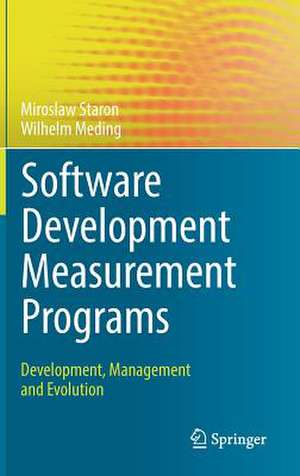Software Development Measurement Programs: Development, Management and Evolution
Autor Miroslaw Staron, Wilhelm Medingen Limba Engleză Hardback – 31 iul 2018
This book seeks to promote the structured, standardized and accurate use of software measurement at all levels of modern software development companies. To do so, it focuses on seven main aspects: sound scientific foundations, cost-efficiency, standardization, value-maximization, flexibility, combining organizational and technical aspects, and seamless technology integration. Further, it supports companies in their journey from manual reporting to automated decision support by combining academic research and industrial practice.
When scientists and engineers measure something, they tend to focus on two different things. Scientists focus on the ability of the measurement to quantify whatever is being measured; engineers, however, focus on finding the right qualities of measurement given the designed system (e.g. correctness), the system’s quality of use (e.g. ease of use), and the efficiency of the measurement process. In this book, the authors arguethat both focuses are necessary, and that the two are complementary. Thus, the book is organized as a gradual progression from theories of measurement (yes, you need theories to be successful!) to practical, organizational aspects of maintaining measurement systems (yes, you need the practical side to understand how to be successful).
The authors of this book come from academia and industry, where they worked together for the past twelve years. They have worked with both small and large software development organizations, as researchers and as measurement engineers, measurement program leaders and even teachers. They wrote this book to help readers define, implement, deploy and maintain company-wide measurement programs, which consist of a set of measures, indicators and roles that are built around the concept of measurement systems. Based on their experiences introducing over 40,000 measurement systems at over a dozen companies, they share essential tips and tricks on how to do it right and how to avoid common pitfalls.
| Toate formatele și edițiile | Preț | Express |
|---|---|---|
| Paperback (1) | 416.96 lei 6-8 săpt. | |
| Springer International Publishing – 12 ian 2019 | 416.96 lei 6-8 săpt. | |
| Hardback (1) | 423.22 lei 6-8 săpt. | |
| Springer International Publishing – 31 iul 2018 | 423.22 lei 6-8 săpt. |
Preț: 423.22 lei
Preț vechi: 529.03 lei
-20% Nou
Puncte Express: 635
Preț estimativ în valută:
81.01€ • 88.02$ • 68.09£
81.01€ • 88.02$ • 68.09£
Carte tipărită la comandă
Livrare economică 21 aprilie-05 mai
Preluare comenzi: 021 569.72.76
Specificații
ISBN-13: 9783319918358
ISBN-10: 3319918354
Pagini: 254
Ilustrații: XIX, 258 p. 120 illus., 40 illus. in color.
Dimensiuni: 155 x 235 mm
Greutate: 0.57 kg
Ediția:1st ed. 2018
Editura: Springer International Publishing
Colecția Springer
Locul publicării:Cham, Switzerland
ISBN-10: 3319918354
Pagini: 254
Ilustrații: XIX, 258 p. 120 illus., 40 illus. in color.
Dimensiuni: 155 x 235 mm
Greutate: 0.57 kg
Ediția:1st ed. 2018
Editura: Springer International Publishing
Colecția Springer
Locul publicării:Cham, Switzerland
Cuprins
1 Introduction.- 2 Fundamentals.- 3 Measurement Program.- 4 Quality of measurement programs.- 5 Tooling in Measurement Programs.- 6 Examples of Measures in Measurement Systems.- 7 New techniques.- 8 Maintaining and evolving measurement programs.- 9 Summary and future directions.
Notă biografică
Miroslaw Staron is Professor in the Department of Computer Science and Engineering at the University of Gothenburg, Sweden. He has published extensively on software metrics, model-driven software development and empirical software engineering and cooperates with Ericsson, Volvo and other telecom companies and car manufacturers.
Textul de pe ultima copertă
This book seeks to promote the structured, standardized and accurate use of software measurement at all levels of modern software development companies. To do so, it focuses on seven main aspects: sound scientific foundations, cost-efficiency, standardization, value-maximization, flexibility, combining organizational and technical aspects, and seamless technology integration. Further, it supports companies in their journey from manual reporting to automated decision support by combining academic research and industrial practice.
When scientists and engineers measure something, they tend to focus on two different things. Scientists focus on the ability of the measurement to quantify whatever is being measured; engineers, however, focus on finding the right qualities of measurement given the designed system (e.g. correctness), the system’s quality of use (e.g. ease of use), and the efficiency of the measurement process. In this book, the authors arguethat both focuses are necessary, and that the two are complementary. Thus, the book is organized as a gradual progression from theories of measurement (yes, you need theories to be successful!) to practical, organizational aspects of maintaining measurement systems (yes, you need the practical side to understand how to be successful).
The authors of this book come from academia and industry, where they worked together for the past twelve years. They have worked with both small and large software development organizations, as researchers and as measurement engineers, measurement program leaders and even teachers. They wrote this book to help readers define, implement, deploy and maintain company-wide measurement programs, which consist of a set of measures, indicators and roles that are built around the concept of measurement systems. Based on their experiences introducing over 40,000 measurement systems at over a dozen companies, they share essential tips and tricks on how to do it right and how to avoid common pitfalls.
Caracteristici
Combines academic research with industrial practice to support companies in their journey from manual reporting to automated decision support Organized as a gradual progression from theories of measurement to practical and organizational aspects of maintaining measurement systems Based on the authors’ experiences introducing over 40,000 measurement systems at more than a dozen companies
